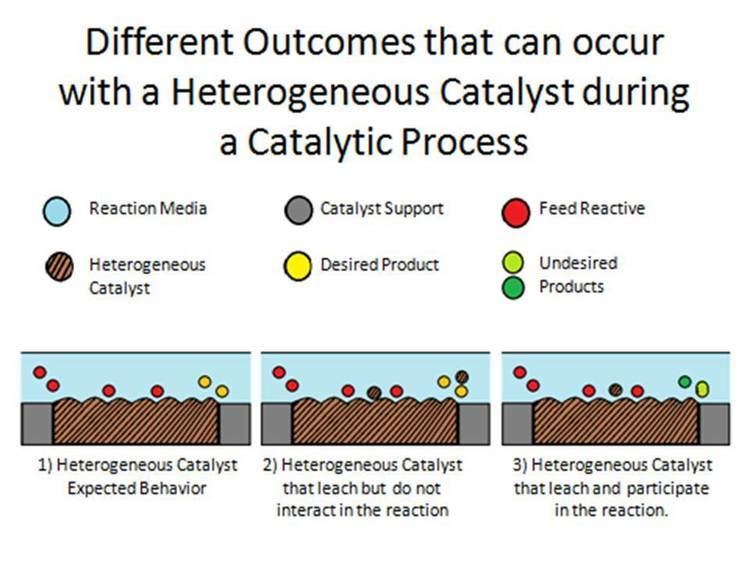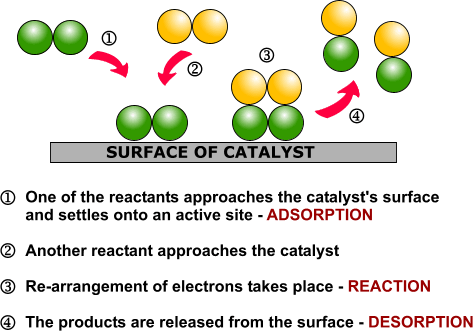 | ||
Mod 01 lec 01 lec 1
In chemistry, heterogeneous catalysis refers to the form of catalysis where the phase of the catalyst differs from that of the reactants. Phase here refers not only to solid, liquid, vs gas, but also immiscible liquids, e.g. oil and water. The great majority of practical heterogeneous catalysts are solids and the great majority of reactants are gases or liquids. Heterogeneous catalysis is of paramount importance in many areas of the chemical and energy industries. Heterogeneous catalysis has attracted Nobel prizes for Fritz Haber and Carl Bosch in 1918, Irving Langmuir in 1932, and Gerhard Ertl in 2007.
Contents
- Mod 01 lec 01 lec 1
- Adsorption
- Types of adsorption
- Surface Reactions
- Concepts
- Classes of heterogeneous catalysts
- Examples
- Other examples
- References
Adsorption

Adsorption is commonly an essential first step in heterogeneous catalysis. Adsorption is when a molecule in the gas phase or in solution binds to atoms on the solid or liquid surface. The molecule that is binding is called the adsorbate, and the surface to which it binds is the adsorbent. The process of the adsorbate binding to the adsorbent is called adsorption. The reverse of this process (the adsorbate splitting from adsorbent) is called desorption. In terms of catalyst support, the catalyst is the adsorbate and the support is the adsorbent.
Types of adsorption

Two types of adsorption are recognized in heterogeneous catalysis, although many processes fall into an ambiguous range between the two extremes. In the first type, physisorption, induces only small changes to the electronic structure of the adsorbate. Typical energies for physisorption are from 2 to 10 kcal/mol. The second type is chemisorption, in which the adsorbate is strongly perturbed, often with bond-breaking. Energies for typical chemisorptions range from 15 to 100 kcal/mol.

For physisorption, adsorbate is attracted to the surface atoms by van der Waals forces. A mathematical model for physisorption was developed by London to predict the energies of basic physisorption of non-polar molecules. The analysis of physisorption for polar or ionic species is more complex.
Chemisorption results in the sharing of electrons between the adsorbate and the adsorbent. Chemisorption is traditionally described by the Lennard-Jones potential, which considers various cases, two of which are.
Surface Reactions
With catalyst supports, the reaction that occurs often occurs on the surface of either the catalyst or the support. In terms of surface reactions there are three mechanisms.
Any surface reaction can be described as following one of these mechanisms, or some combination of these mechanisms. In addition, all of these above mechanisms can occur in reverse. In general, the pathway for a reaction on a surface is as follows. First the reactants adsorb onto the surface. Through a series of bonds being formed and being broken, adsorbed intermediates are produced and destroyed. Then the final product(s) is produced and it desorbs from the solid. Most metal surface reaction occur by chain propagation.
Concepts
In heterogeneous catalysis, the reactants diffuse to the catalyst surface and adsorb onto it, via the formation of chemical bonds. After reaction, the products desorb from the surface and diffuse away. Understanding the transport phenomena and surface chemistry such as dispersion is important. If diffusion rates are not taken into account, the reaction rates for various reactions on surfaces depend solely on the rate constants and reactant concentrations. For solid heterogeneous catalysts, the surface area of the catalyst is critical since it determines the availability of catalytic sites. Surface areas can be large, for example some mesoporous silicates have areas of 1000 m2/g. The most common approach to maximizing surface area is by the use of catalyst supports, which are the materials over which the catalysts are spread.
Classes of heterogeneous catalysts
Although the majority of heterogeneous catalysts are solids, many variations exist.
Examples
Many examples exist, the table emphasizes large-scale industrial processes, although diverse examples are known.
